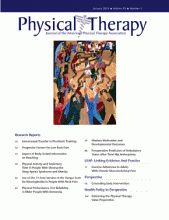Abstract
Background Total hip arthroplasty (THA) is an effective procedure that provides patients with long-term relief from pain and enables them to resume their normal daily activities. Preoperative instruction about the functional outcomes and optimum goal of rehabilitation is helpful for patients undergoing THA.
Objective The purposes of this study were: (1) to examine the relationships between preoperative physical functions and ambulation following THA and (2) to identify optimal cutoff values for estimating ambulatory status at 6 months after THA.
Design This was a retrospective study.
Methods The study participants were 204 patients who underwent a unilateral THA. Hip abductor and knee extensor strength were measured and the Timed “Up & Go” Test (TUG) was conducted preoperatively. The patients were divided into 2 groups according to self-reported walking ability at 6 months postoperatively: an independent ambulation group (n=118) and a cane-assisted ambulation group (n=86). Differences between the 2 groups were examined using an unpaired t test or the chi-square test. A stepwise multiple logistic regression analysis was performed with walking ability at 6 months postoperatively as a dependent variable and age, sex, contralateral hip osteoarthritis (ie, whether a participant had contralateral hip osteoarthritis or not), body mass index, hip abductor strength, knee extensor strength, and TUG score as independent variables. Receiver operating characteristic curve analysis was used to identify a cutoff point for classifying the participants into the 2 groups.
Results A stepwise multiple logistic regression analysis selected 3 factors (age, knee extensor strength, and TUG score) as significant variables affecting the midterm ambulatory ability after THA. Moreover, receiver operating characteristic curve analyses revealed that the midterm (ie, 6-month) ambulatory status after THA was more accurately predicted by the patient's TUG score (cutoff point=10 seconds, sensitivity=76.7%, specificity=93.2%, area under the curve=0.93) than by age and knee extensor strength.
Limitations The categorization of ambulatory status in this study was based solely on self-reported walking ability.
Conclusion The findings indicate that patients with a preoperative TUG score of less than 10 seconds are likely to walk without an assistive device at 6 months after THA.
Footnotes
Mr Nankaku, Dr Kakinoki, Ms Fujita, and Professor Matsuda provided concept/idea/research design and project management. Mr Nankaku, Dr Tsuboyama, and Professor Matsuda provided writing. Mr Nankaku, Dr Akiyama, Mr Nishimura, and Mr Yoshioka provided data collection. Mr Nankaku, Ms Fujita, and Ms Kawai provided data analysis. Dr Akiyama provided study participants. Professor Matsuda provided facilities/equipment, institutional liaisons, and consultation (including review of manuscript before submission).
All of the procedures in this study were approved by the Ethics Committee of Kyoto University Graduate School of Medicine and Faculty of Medicine.
- Received January 20, 2012.
- Accepted September 17, 2012.












